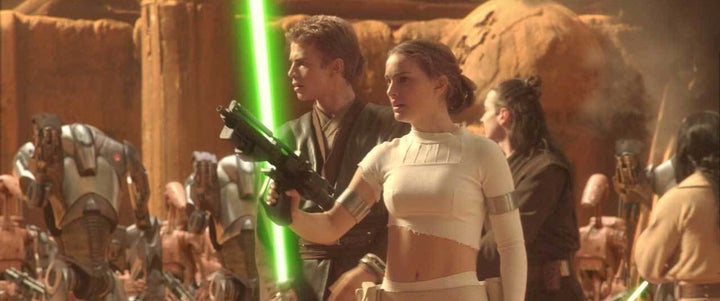
Star Wars may be set in a galaxy far, far away but it’s still a man’s world. The franchise extensively explores male relationships (father and son, master and padawan, uncle and nephew) at the expense of creating well developed, complex female characters.
Although The Force Awakens, Rogue One and The Last Jedi have attempted to redress the previous films’ gender imbalance, Rey and Jyn Erso are still lone women, surrounded by truck loads of male soldiers, male pilots and male droids, akin to Leia in the original trilogy. However, no female character in Star Wars is as isolated, poorly written and neglected as Padmé Amidala, mother of Luke and Leia and wife of Darth Vader, played by Natalie Portman in all three Star Wars prequels.
Over the course of the trilogy Padmé transforms from a powerful and revered queen, to a narrative necessity who only has the power to order C-3PO to make her a cup of tea (hold the blue milk). In The Phantom Menace she is leader of war-torn Naboo, wields a laser gun and scales palace walls to free her besieged citizens. However, in the following film she is shunted away from the action and sent to frolic in fields with Anakin Skywalker (soon to be Darth Vader) and eat some pears, creepily cut up and fed to her by the angsty jedi.
By Revenge of the Sith, Padmé is pregnant with Luke and Leia and no longer a queen or senator. Whilst Obi-Wan Kenobi and Anakin hop across planets Padmé seems chained to her penthouse, and spends most of the film gazing across skylines and weeping over Anakin. This is supposed to be the same woman who insisted on exploring the gangster-ridden nucleus of Tatooine when she was but a teen queen and fought off a monstrous sabretooth tiger in a gladiator ring.
“Padmé transforms from a powerful and revered queen, to a narrative necessity who only has the power to order C-3PO to make her a cup of tea.”
Padmé’s character is an inconsistent as Hayden Christensen’s acting. In Attack of the Clones she sees Anakin as little more than a stroppy teen until suddenly she cannot resist his leering stares and clunky chat-up lines. In The Phantom Menace she returns to Naboo with a plan to save her subjects, even though this could mean her death. We cry: how noble! How selfless! Until we realise this plan involves hundreds of Gungans dying in a battle aimed at distracting the droid army.
These inconsistencies are because Star Wars creator George Lucas, who directed the prequels, could not be bothered to establish Padmé’s motives or inner thoughts. She is merely a tool to hurry Darth Vader’s genesis and an unwilling recipient of Anakin’s fears and desires which lead to his transformation. Insights into Padmé’s character are substituted for many, unnecessary outfit changes. In one scene we are shown a section of Padmé’s rooms. This could have been an opportunity to learn something about Padmé- what books does she read? Does she exercise? Is she obsessively tidy or does she revel in mess? Instead all we see are open wardrobes, stuffed with an obscene amount of dresses and robes. Watching other scenes, it is clear Lucas knows that setting and imagery are powerful tools for aiding characterisation. Darth Sidious and Yoda’s battle takes place in the senate, Sidious ripping apart the building and hurling podiums at Yoda - showing how he has manipulated the political system all along. Lucas purposefully chose to emphasise Padmé’s outward appearance (her clothes and wardrobe), and imply that all she does when she’s not on screen is change outfits, because he does not care about developing her personality, her subtleties or her flaws. This is redolent of Leia’s famous golden bikini scene in Return of the Jedi, where director Richard Marquand lingers on Leia’s bare and enslaved body, rather than focus on her mental anguish, which she would inevitably be feeling.
“Insights into Padmé’s character are substituted for many, unnecessary outfit changes.”
Padmé’s thinly drawn shadow hangs over The Force Awakens, Rogue One and The Last Jedi. Whether written intentionally or not Rey and Jyn are everything Padmé isn’t. Rey is never consumed by her relationship with Han Solo or Kylo Ren, and her role grows significantly, rather than diminishes, in The Last Jedi. Annoyingly, in her most recent appearances Leia seems to have developed her mother’s habit of remaining static in a room, watching through a window as the action unfurls.
Star Wars fans must remember Padmé, as drippy and unexciting as she becomes and say: never again. Never again will a woman in Star Wars be so unevenly written, with so little care- reduced to a human incubator, draped in a space nightie. Disney, we will be watching.
